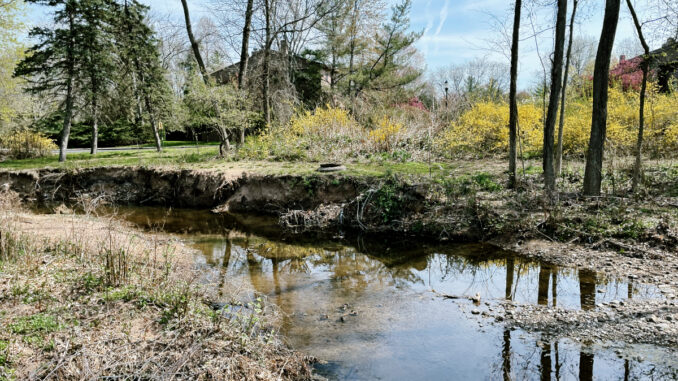
TOWNSHIP OF WASHINGTON—Among agenda items at its July 10 meeting, the town council heard from Frank Rossi of Boswell Engineering: a 40-minute overview of a Boswell-conducted drone study of the Musquapsink Brook, a Category One waterway that flows on a 3.6-mile course through the township.
A special meeting is set for Monday, July 24 at 7 p.m. at town hall for residents to ask questions regarding the Musquapsink Brook Condition Assessment report. The mayor and council and an engineer from Boswell Engineering will be on hand.
Send related questions you may have by July 20 to Mayor Peter Calamari at pcalamari@twpofwashington.us or administrator Mark DiCarlo at mdicarlo@twpofwashington.us.
The 70-page report, available on the town website, was issued in February. Council appeared concerned about “critical sanitary issues” raised in the report, which revealed sanitary sewer concrete manholes exposed to the brook on several sides and near eroded stream banks.
We reported on the study, including the critical sanitary sewer line concerns, in “Drone study highlights brook obstructions; recommends ways to improve flow, stem flooding,” Michael Olohan, April 17, 2023.
The report lists nearly 100 obstructions, including 45 downed trees and 33 sediment shoals, along the major Pascack Brook tributary.
The report notes, “The current condition of the bank near critical sanitary issue 7-1 should be reconstructed with the utmost priority. A flooding event could result in a failure of the sanitary system causing approximately 25% of the town’s untreated sanitary flow to discharge directly into the brook.”
The manhole appears to be near Pascack Road, possibly near new construction by the former tennis facility. Officials did not identify the potential manhole location during the meeting.
DiCarlo wondered about who might be responsible for fixing the sanitary manhole situation, and Rossi said to determine who owns the exposed sanitary line. Rossi said if it was a Bergen County Utility Authority manhole, it would say BCUA on it.
He said should the manhole be municipal property, the township would have to apply for an emergency permit and the nearby stream bank would need to be rebuilt and stabilized to protect the sanitary line.
Rossi said the sanitary line manhole should be identified on a county sewer map. He said BCUA should be notified if the sanitary line is their property.
“Obviously, this is a priority,” Morgan said.
Rossi agreed: “Definitely, you should take care of it.” He suggested the manhole should have a watertight cap on it and no holes for water to possibly enter.
Rossi said with an emergency permit authorization from DEP, Boswell could begin work in 30 days, and that it must be completed within 60 days, or a total of 90 days.
Councilman Tom Sears said that DiCarlo should be the point of contact on addressing the sanitary line issue.
Rossi noted that downed trees have always been a problem, causing blockages and reducing stream flows, in Pascack Brook and tributaries.
Rossi suggested that clearing trees from brooks and stabilizing eroded stream banks would help to lessen flooding from nuisance storms.
He said dirt removed from sentiment shoals could be used to repair eroded stream banks but that its disposal was costly. This was due to high costs for sediment testing required by DEP, he said.
He said the county mosquito commission no longer removes downed trees from brooks or streams, but may loan their equipment to towns who have qualified heavy equipment operators on staff. He said generally stream bank stabilization and shoal removal projects are “very cumbersome” and often take 6–9 months to obtain the required DEP permits.
Rossi suggested that local officials might first wish to look at where stream bank failures are and consider the use of shoal material to recreate the bank. He said the DEP views this as a riparian restoration.
Moreover, he suggested fixing headwalls, or concrete structures that anchor stormwater and stream flows going under bridges and roadways, as well as repairing eroded stream banks. He said federal grant funding was previously available through Natural Resources Conservation Service (NRCS) but may not still be available.
“Don’t dredge; fix the headwalls and stabilize stream banks. That’s the long and short of it,” Rossi said.
